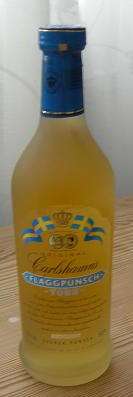Punsch

Punsch (not to be confused with punch) is a traditional liqueur in Sweden and Finland (known as punssi in Finnish), produced from arrack, other spirits (often brandy or rum), sugar and water. Arrack, first imported to Sweden from Java in 1733, is the base ingredient of punsch. Punsch usually have 25% alcohol by volume (ABV) and 30% sugar.[1]
Etymology
Originally, Swedish/Finnish punsch was a variant of punch, which became a popular drink all over Europe in the 18th century, having been introduced in Britain from India in the late 17th century. The word punch/punsch is a loanword from Sanskrit पञ्च (pañc), meaning "five", as punch was originally made with five ingredients: alcohol, sugar, lemon, water, and tea or spices.[2] The English spelling of the word was in Sweden and Germany adapted to local spelling rules, thus becoming punsch.[3] In Sweden, regular punch is also served, but in order to differentiate it from the liqueur known as punsch, it is known as punschbål (punch bowl) or simply bål (bowl).
History of punsch
The Swedish East India Company started to import arrack with the arrival of their ship Fredricus Rex Sueciae to Gothenburg in 1733. It quickly became popular, especially among the wealthy, who could afford the price of imported goods. Later it spread through all levels of society.[4]
A testament to the widespread popularity of punsch or rack (arrack)[5] is the songs of Swedish eighteenth century poet and composer Carl Michael Bellman. It is often mentioned in his three works Bacchi Tempel (1783), Fredmans Epistlar (1790) and Fredmans Sånger (1791) about a group of fictional characters, drunkards, bohemians and prostitutes in contemporary Stockholm. (See for example song no. 48 or epistle no. 41.)[6]
Until the 1840s, punsch was served as a warm punch, created just before consumption: a sugarloaf was placed upright in a large bowl, hot water was poured over it to make the sugar dissolve, and arrack, unflavoured spirits and German Rhine wine was added. Still warm, the drink was then served in cups.[4] However, in 1845 wine importing company J. Cederlunds Söner started selling premixed punsch in bottles, quickly followed by several other manufacturers, and the habit of drinking punsch cold as a liqueur began to take hold.[3] However, punsch is still traditionally served hot with Swedish pea soup, commonly on Thursdays.[3]
The high point of punsch consumption was during the late nineteenth century, when the Swedes started frequenting restaurants and loved to end their dinner with coffee and half a bottle of punsch on the table, placed in an ice bucket. Many drinking songs from that period are about the consumption of punsch.[3]
Uses
Apart from being drunk neat, punsch may be used in cocktails. It is also a vital ingredient in the popular Swedish chocolate praline, known as punschpralin, and the pastry known as punschrulle.
Common Nordic brands
- Carlshamns Flaggpunsch (Sweden)
- Cederlunds Caloric (originally Sweden, but now manufactured in Finland)
- Facile Punsch (Sweden)
- Trosa Punsch (Sweden)
- Helmi Arrakkipunssi (Finland)
Defunct brands
- Grönstedts Blå
- Bil-Punsch (Car Punsch)
- Hushålls-Punsch (Household Punsch)
- Kavalleri-Punsch (Cavalry Punsch)
- Sport-Punsch (Sports Punsch)
- Telefon-Punsch (Telephone Punsch)
- Lunda-punsch
See also
- Punch - a cold drink mixed with fruit
- Punsch-roll - Punschrulle pastries
References
- ↑ "Punsch". Nordiska Familjebok, Uggleupplagan via Project Runebergh (in Swedish) 22. Stockholm: Nordisk familjeboks förl. 1915. p. 609. Retrieved 7 August 2014.
- ↑ Punch at the Online Etymology Dictionary
- 1 2 3 4 Spritmuseum: Punsch - varm eller kall (Swedish only) Relinked 2015-12-17
- 1 2 Karlshamns kulturkvarter: Punsch & Spelkort - Mera punsch (Swedish only) Relinked 2015-12-17
- ↑ Bellman, Carl Michael. "N:o 9 Måltidssång" [No. 9 Meal song]. www.runeberg.org. Project Runeberg. Retrieved 7 August 2014.
- ↑ "Texter och musik" [Texts and lyrics]. www.bellman.net. Thord Lindé. Retrieved 7 August 2014.